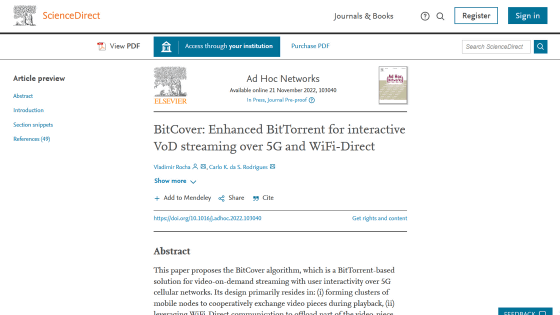A mechanism using BitTorrent and Wi-Fi Direct is devised to improve the video distribution service in the 5G era

In recent years,
BitCover: Enhanced BitTorrent for interactive VoD streaming over 5G and WiFi-Direct - ScienceDirect
https://doi.org/10.1016/j.adhoc.2022.103040

Professor Vladimir Rocha, who studies computer engineering at ABC Federal University in Brazil, and others point out that cellular network capacity has been a bottleneck since the advent of video distribution services. Although this has improved at once with the advent of 5G, the bandwidth capacity of the backhaul line that connects the ``donor station'' that connects to the network and the ``relay node station'' that makes up the terminal access area is still a bottleneck in 5G communication. It is said that there is a possibility of becoming.
The research team cites that one option to solve this problem is to optimize bandwidth usage within base stations by deploying effective bandwidth sharing algorithms. Rocha et al. propose a useful algorithm for maximizing the use of 5G communication, BitTorrent, which is a file transfer protocol using Peer to Peer , and Wi-Fi compatible using wireless LAN. An algorithm that uses Wi-Fi Direct, in which devices communicate directly with each other.

Normally, devices that use video distribution services download the data of the part they are watching from the server. If all data is to be downloaded over 5G communication, the backhaul line may become a bottleneck due to the traffic load within the 5G base station.
However, the new algorithm, dubbed BitCover by the research team, not only downloads data from a server using 5G, but also peers nearby devices that already own the downloaded data. It also does BitTorrent based file sharing. The idea behind the algorithm is that this will reduce the amount of communication that uses 5G and ease the traffic on the backhaul line.
Communication between devices is done via Wi-Fi Direct, and we are rolling out a new peer selection policy that prioritizes peers with data to improve communication channels. Whether to use 5G or Wi-Fi Direct is said to depend on the physical distance between the two communication endpoints.
The research team said, ``This article aims to provide useful insights for multimedia application projects, mainly targeting interactive video delivery over 5G cellular networks.''

Related Posts:
in Mobile, Web Service, Posted by log1h_ik







